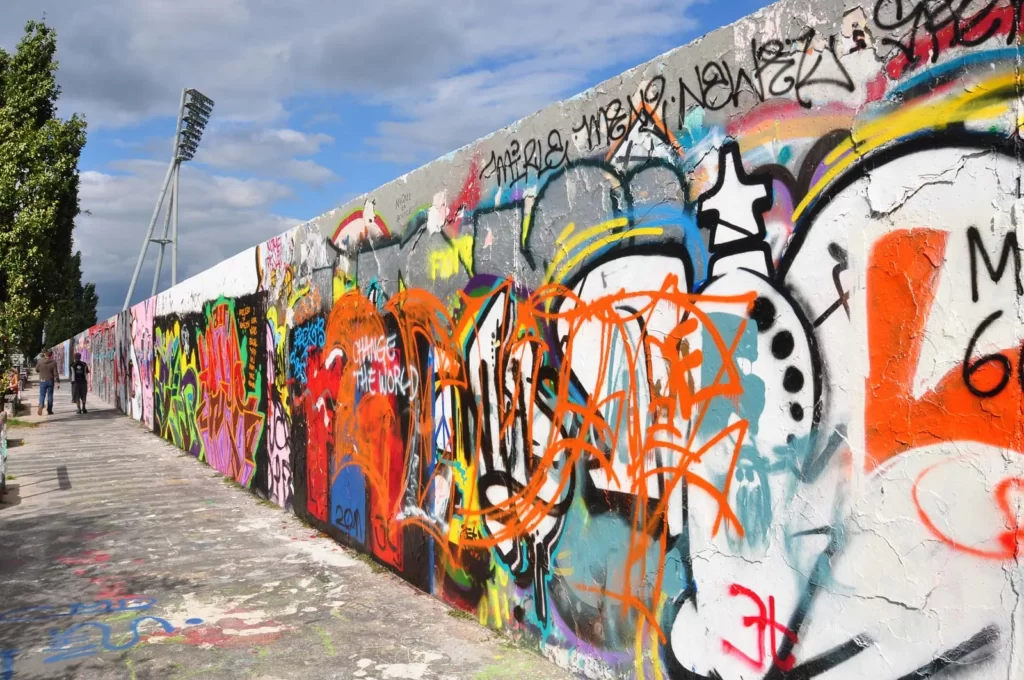Graffiti is art that is written, painted or drawn on a wall or other surface, usually without permission and within public view. Graffiti ranges from simple written words to elaborate wall paintings. Graffiti is a way to express your anger against the government. It is also a part of hip-hop (Hip Hop has multiple branches like Djing, MCing, Breakdancing and Graffiti). Graffiti served as a called to action, conveying political messages and ideologies to the masses.
History of Graffiti
The roots of graffiti can be traced back to ancient civilisations such as Rome, Greece, and Egypt, where inscriptions and drawings were etched onto public walls and monuments. These early forms of graffiti were often used for political, religious, or personal purposes. Over time, graffiti’s role as a means of communication and artistic expression continued to evolve, eventually laying the groundwork for the vibrant and diverse graffiti art scene we know today.
The history of graffiti art is rich and diverse, with countless artists making significant contributions to the evolution of this dynamic form of expression. By examining the works of Cornbread, TAKI 183, Lady Pink, and Keith Haring, we can gain a deeper appreciation for the development of graffiti art and the unique styles and themes that have shaped it over time. As graffiti continues to gain recognition as a legitimate art form, we can expect to see even more innovative and thought-provoking works emerge from this ever-evolving medium.
Impacts created by Graffiti
1. Hip-Hop Culture
Visual Element: Graffiti is one of the four key elements of hip-hop culture, alongside MCing (rapping), DJing, and breaking (dance). It contributes to the visual aesthetics of hip-hop and is often associated with the vibrant and colourful style of the movement.
Self-Expression: Graffiti allows artists to express themselves creatively and visually, much like MCs express themselves through lyrics. This self-expression is a fundamental aspect of hip-hop culture.
2. Street Art and Urban Culture
Legitimization: Graffiti has played a crucial role in legitimizing street art as a legitimate form of artistic expression. This has led to graffiti artists gaining recognition in the art world and their works being displayed in galleries and museums.
Revitalization: Graffiti and street art have been used to revitalize urban areas by adding colour and vibrancy to often neglected spaces. Cities like Berlin, New York, and São Paulo have embraced street art as a tourist attraction.
3. Advertising and Marketing
Street Marketing: Some companies have used graffiti-inspired advertising campaigns to connect with younger, urban audiences. This guerrilla marketing tactic can help create buzz around products or events.
Brand Collaboration: Graffiti artists may collaborate with brands to create custom artwork or limited-edition products, bridging the gap between street art and commercial ventures.
4. Tourism and Cultural Exchange
Tourist Attractions: Cities with a vibrant graffiti scene often attract tourists interested in street art, contributing to local economies.
Cultural Exchange: Graffiti artists and their works travel internationally, fostering cultural exchange and collaboration among artists from different backgrounds.
It’s important to note that graffiti is a complex and multifaceted art form, and its impact can vary greatly depending on the context and the intentions of the artists involved. While some view it as a form of self-expression and a means of reclaiming public spaces, others see it as vandalism. Graffiti continues to evolve and adapt, leaving a lasting impression on various industries and urban culture.
So, in the next blog, we are going to discuss how Grafitti came to India and how it became famous.
If you’re a business owner and want to make your small business space stand out with vibrant art? Check out our Portfolio. Reach out now and let our graffiti artists turn your walls into eye-catching masterpieces! CONTACT US

